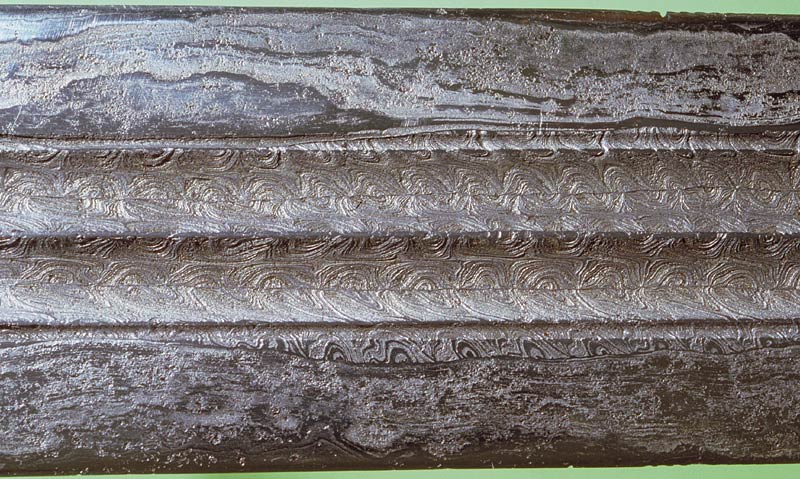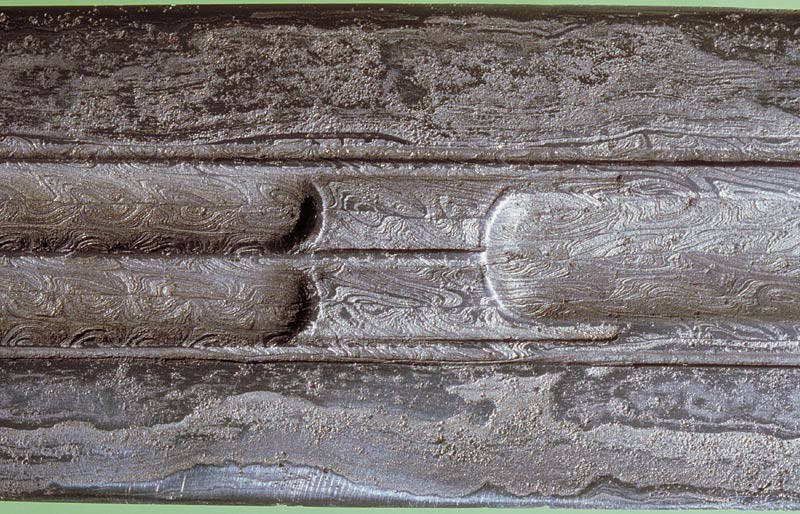
 |
|
|
#1 |
|
Member
Join Date: Dec 2004
Posts: 655
|
Dear All,
I'm sorry for probably a stupid question - I'm really fond of caucasian kindjals. Unfortunately by far most of the pieces I've seen are not of the quality I expect - soft steel, not damascus, sometimes in 500$ silver kubachi scabbards, whethter it's on ebay or oriental-arms. What I really would like to know, is how hard is it to find a real dagger - not Bazalai, but damascus of a good maker. And how is it possible to see if it's damascus if the dagger is badly out of polish and basically covered with patina. Thank you very much, K.Rivkin |
|
|

|
|
|
#2 |
|
Member
Join Date: Dec 2004
Location: Ann Arbor, MI
Posts: 5,503
|
Basically, Caucasian swordmakers rarely made damascus blades. It was just too damn expensive and time consuming and the profit margin was low. They did some differential tempering, though, and there are some Caucasian swords with real "Hamon".
But, as we discussed before, most of their manufacture went to Russian officers almost as souvenirs. Under the circumstances, there was no sense to waste time on quality blades: gorgeous silver scabbard would be the main selling point. What then about really old blades, made before the Russian invasion ( military and cultural)? Sadly, they were remounted, reforged, lost, rusted.... The locals had so little iron around that every unused piece was recycled. That's the reason why one can find really old blades mainly in the Russian museums, and those were acquired long before the 1917 Revolution..... The kinjals we see these days are mostly beautiful, classy and expensive tourist pieces..... |
|
|

|
|
|
#3 | |
|
Member
Join Date: Dec 2004
Location: Athens Greece
Posts: 479
|
I have not seen any kindjal with real damasus blade. If anyone has please post it here. I have seen some etched damasus.
Quote:
Also there is a real factory of fakes on. Somewhere in Georgia as far as I can tell. My kindjals are here |
|
|
|

|
|
|
#4 |
|
Member
Join Date: Dec 2004
Location: Ann Arbor, MI
Posts: 5,503
|
What I meant by "tourist pieces" is that the kindjals produced at the end of the 19th-beginning of 20th century were not meant for fighting anymore: the nature of warfare has changed. They were part of the uniform (Cossack units or ethnic units such as the mainly Chechen "Wild Division" of the Tsarist military) and were often viewed as an impediment rather than weaponry ( see B.E. Frolov "Oruzhiye Kubanskikh Kasakov", ie "Weapons of the Kuban Cossacks"). They were also a part of the national dress of Caucasian nations and as such, were worn mainly for ceremonial functions and they were also made as souvenirs and artistic objects (many still have the inscription "KABKA3"). Nothing bad or dishonorable about it, but they were just no longer real weapons meant for battle. Just as AK-47 obliterated the need in Kaskaras and Shamshirs, Mosin-Nagant rifle made the Caucasian kindjals obsolete....
Still, the memory of their real function was still fresh at that time and the quality of work was truly superb. In cotrast, after so many years of neglect and virtual ban on the manufacture of any weaponry in the former USSR the new pieces mass produced in Georgia these days have no meaning at all and, in my opinion, do not even qualify as collector pieces. Just look at their blades and vomit! |
|
|

|
|
|
#5 |
|
Member
Join Date: Dec 2004
Posts: 655
|
Well, I have dozen or so kindjals with a real damascus pattern - turkish star night, burly pattern etc. Scabbards are very inexpensive, but the blades are the real beauty, through I strongly suspect 25% of them can be etchings, but others - it's physically impossible to etch starry damascus.
Getting them was tough, and involved in most cases personal contacts. I hope to post some pictures soon. |
|
|

|
|
|
#6 |
|
EAAF Staff
Join Date: Nov 2004
Location: Upstate New York, USA
Posts: 982
|
Does anyone know where would this be from?
  
|
|
|

|
|
|
#7 |
|
Member
Join Date: Dec 2004
Posts: 655
|
Damn it. Here we are posing as experience collectors, and Mr.Jones comes with his dagger that is surely a better one.
It's from Dagestan, made most likely by Lak master, can be that master worked outside of Dagestan, but it's unlikely. The date I would guess 1860 and may be a little bit up. P.S. Sorry for the direct question, but where did you get it ? It seems to be a VERY good piece. |
|
|

|
|
|
#8 |
|
Member
Join Date: Dec 2004
Posts: 655
|
Yet again, as in my experience - the hilt and scabbard are usually simplistic.
|
|
|

|
|
|
#9 | |
|
Member
Join Date: Dec 2004
Location: B.C. Canada
Posts: 473
|
Quote:
Can someone refresh my memory? I thought I read that the weapons with plain wood hilts were considered tools and not taxed or taken by the Russians / Ottoman, while the ornate hilts where considered weapons instead of tools and were. I can't for the life of me remember where (or even if i read this). Thanks Jeff |
|
|
|

|
|
|
#10 |
|
Member
Join Date: Dec 2004
Posts: 655
|
It's true in some sence, however there is a different reason for the fact that most damascus blades have simple hilts - they were made prior to 1860, prior to the point when Kubachi hilts and scabbards became "must have" in order to sell it.
|
|
|

|
|
|
#11 |
|
Member
Join Date: Dec 2004
Location: Athens Greece
Posts: 479
|
Ariel
You have right that late 19th century kindjal became more asthetic than useful objects. But they still could kill someone in close combat or tavern fight. It is the same that happened to yataghans, cretan knifes etc. We know from history books that some greek guerillas till the end of WWII had swords and big knifes and they USED them in battles.  Dr Jones Thank you for the picture. It is amazing. Any other damascus kindjal? |
|
|

|
|
|
#12 |
|
Member
Join Date: Dec 2004
Location: Europe
Posts: 2,718
|
Many are in closed private collections.
Jens |
|
|

|
|
|
#13 |
|
Member
Join Date: Dec 2004
Posts: 655
|
I do apologize if my previous posts where poorly mannered - I'm still jelous like hell, this guy is such a beauty !
|
|
|

|
|
|
#14 |
|
EAAF Staff
Join Date: Nov 2004
Location: Upstate New York, USA
Posts: 982
|
The blade on the one I posted above is just over 36 cm / 14 inches in length and just under 4.5 cm / 1.75 inches wide at the base. The fullers are so deep in this 4.5 mm thick blade that in just a few foci, light will pass through a few pinprick sized holes in the blade where fuller meets fuller. The smith obviously had to remove a lot of metal and did so with great precision. The hilt, though plain, may well be made of rhino horn and is very well shaped and fitted. The iron rivets are nicely faceted and over a cm high. I have never had a scabbard, so unfortunately, this exceedingly sharp dagger is sheathed in newspaper bound with masking tape.
 I found it at an arms fair several decades ago; I was told that it was part of a collection of pattern-welded items that was being dispersed. I found it at an arms fair several decades ago; I was told that it was part of a collection of pattern-welded items that was being dispersed.
|
|
|

|
|
|
#15 |
|
Member
Join Date: Dec 2004
Posts: 655
|
Sorry, it's most likely not a rhino horn - I've never seen those used by caucasians. What really puzzles me is that this piece is unsigned - Dagestanians usually do sign their pieces.
|
|
|

|
|
|
#16 | |
|
Member
Join Date: Jan 2007
Posts: 181
|
Quote:

|
|
|
|

|
|
|
#17 | |
|
Member
Join Date: Jul 2006
Location: musorian territory
Posts: 481
|
Quote:
but shurly there is plenty old kindjals with fine blades to be had.... |
|
|
|

|
|
|
#18 |
|
Member
Join Date: Aug 2007
Location: CHRISTCHURCH NEW ZEALAND
Posts: 2,818
|
Picked this up in a local auction last week.
Would appreciate comments. Overall length is 24 3/4". Blade 17 7/8". 
|
|
|

|
|
|
#19 | |
|
Member
Join Date: Dec 2005
Posts: 692
|
Quote:
At least two of them are on the swap forum....     
|
|
|
|

|
|
|
#20 |
|
Member
Join Date: Dec 2004
Location: Europe
Posts: 2,718
|
Hi Rivkin,
Some of these weapons are in the Moser Collection in Bern – not on exhibition at the moment. Moser who was Swiss lived with his patents in Sct. Petersburg. His father was a watchmaker, and even made watches for Faberge. The young Moser found it boring to make watches, so when he had finished school in Switzerland he joined the Russian army. As he found this boring too, he started to travel in Russia and Caucasus, buying weapons and other things, while he was employed in different places now and again. Some of the swords he got for a bottle of VodkaJ. |
|
|

|
|
|
#21 | |
|
Member
Join Date: Dec 2004
Location: Athens Greece
Posts: 479
|
Quote:

|
|
|
|

|
|
|
#22 | |
|
Member
Join Date: Dec 2004
Location: Ann Arbor, MI
Posts: 5,503
|
Quote:
 I wonder whether some day Georgians might request to get their national treasures back. |
|
|
|

|
 |
|
|